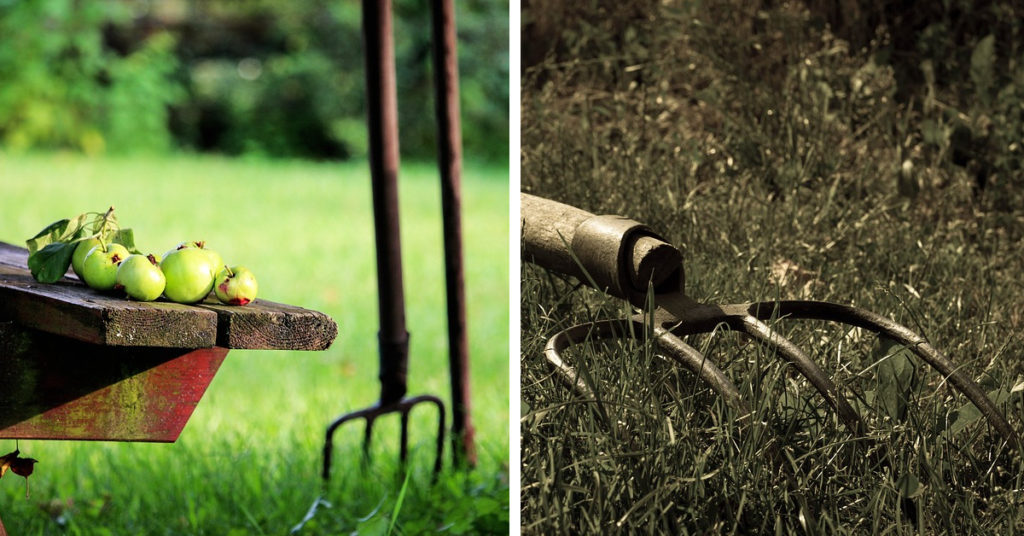Last Updated on March 25, 2024 by Editors
Have you ever wondered how people use pitch forks for gardening? Many people don’t know that there is a type of pitchfork called the Garden Fork. Using a garden pitchfork or a manure fork can help you with many tasks, such as digging, aerating the soil, moving mulch, which can help your garden grow bigger.
Below is an in-depth overview of the pitchfork’s types that are used in gardens.
Table of Contents
What is a Pitch fork?
Pitchforks or Pitch Forks are mostly farm tools in the shape of a large fork with a long handle and two to five or more sharp metal points (tines – teeth), used especially for lifting and moving hay, manure, leaves etc.

What is a Garden Pitchfork?

Garden Pitchforks are pitch forks designed predominantly for gardening tasks. The classic pitchforks are used for “above the ground” jobs. On the other hand, the garden pitchforks can be used for both “above the ground” and “into the soil” garden tasks, depending on the garden pitchfork type.
Types of Garden Pitchforks
There are many types of pitchforks for gardening jobs. They are divided in two main categories:
- Garden Pitchforks for digging.
- Garden Pitchforks for moving materials.
The Garden Fork is the best example of the digging category. The Manure Fork is the most characteristic example for moving materials.
1. Garden Forks – The kings of digging Garden Pitchforks
These days the most common type of pitch fork tools that can be used for gardening tasks is the Garden Fork. Garden Forks are multipurpose garden tools with a handle and a steel head with four sturdy tines. They usually have tines with sharp tip which enables them to penetrate soil easily.
What are Garden Forks used for?
The Garden Forks are used for uprooting weeds and garden plants, digging, loosening, aerating and turning soil. A strong person can use them to turn compost piles. These garden hand tools can be used to aerate lawn like a spike aerator too. Also, the Garden Fork tool can break up the clumps of clay soil that a garden rake can’t break. It can penetrate compacted or rocky soil that a spade or a digging shovel cannot penetrate easily. On the other hand, the Garden Forks can be used for moving material like mulch with little success; there are better types of forks for this task like the Manure or Ensilage forks.
2. Digging Forks or Spading Forks
 The Spading Fork and Digging Fork are smaller versions of the Garden Fork. They also have a head with four tines, which are always flat, and can be used for light digging , to turn soil etc. Unfortunately, they suffer from one fundamental problem: They are not as large or heavy as they should be. To make things worse, there are still some pitch forks for gardens on the market that are advertised by their manufacturers as Digging Forks but are not suitable for digging because the tips of their tines are quite blunt! Because of that they can’t penetrate soil with ease.
The Spading Fork and Digging Fork are smaller versions of the Garden Fork. They also have a head with four tines, which are always flat, and can be used for light digging , to turn soil etc. Unfortunately, they suffer from one fundamental problem: They are not as large or heavy as they should be. To make things worse, there are still some pitch forks for gardens on the market that are advertised by their manufacturers as Digging Forks but are not suitable for digging because the tips of their tines are quite blunt! Because of that they can’t penetrate soil with ease.
Garden Forks vs Digging Forks or Spading Forks
For convenience reasons many garden tool manufacturers state that their garden pitchfork models are Garden Forks, but also Digging forks and Spading forks at the same time. In the past each one of the Garden Fork, Digging fork and Spading fork was slightly different than the others. But these days those garden pitch forks are the same garden hand tool most of the times. The main difference is that the Garden Forks are the big brothers of Digging Forks or Spading Forks. The Garden Forks tend to be longer and heavier than Digging forks or Spading forks and can be used for breaking up hard soil.
3. Potato forks
Potato forks are pitchforks that look like garden forks but have broader blunt tines. Although they can be used for digging loose soil, their main purpose is to harvest sweet potatoes and similar types of vegetables.
4. Broadforks and Broad Forks
The Broadfork or Broad Fork, also known as U-fork or grelinette, is a two-handed garden tool that has a U shape, two handles and usually five or more long and sturdy tines. The broadfork garden tool is used in large gardens for breaking up hard soil and heavy-duty weeding. Also, you can use Broad Forks to loosen and aerate soil, or harvest root vegetables.
5. Manure Forks: The Garden Pitchforks for moving materials
The Manure Fork resembles a Garden Fork, but the tines of this useful garden tool are usually more – five to six -, longer and curved compared to the tines of the standard Garden Fork.

Because of the above mentioned form, the Manure Fork is not a digging oriented garden hand tool. It’s used for lifting, scooping manure and moving large amounts of loose material like mulch or compost.
The long handled Manure Forks that have heads with four to five tines can be used to lift and move thin and long fallen tree and shrub branches with safety and great ease. They are very useful for this gardening task especially when you have to deal with thorny branches.
The Manure Fork is sometimes called as bedding fork, ensilage fork or stable fork. The reason for this is that all of these garden pitchforks are used for moving loose material.
6. Bedding Forks
Bedding Forks look like Manure Forks. Their difference is that they tend to have more tines than the Manure forks. They have about ten long, thin tines. Bedding Forks are used to transfer manure, bedding, straw, hay or other loose material.
7. Ensilage forks
Ensilage Forks usually have ten oval tines similar to Bedding Forks. Most of them have smaller handles than the Bedding Forks and Manure Forks but their purpose is the same: to move loose material. Their handle is D shaped for a more secure grip. Also, because of their more compact and sturdier design they can be used to turn compost piles.
8. Garden Hand Forks
 The Garden Hand Fork is a one handed small gardening fork with 3 to 4 tines.
The Garden Hand Fork is a one handed small gardening fork with 3 to 4 tines.
These hand forks are used for delicate digging, loosening and aerating soil in smaller areas and safely planting and transplanting. However, the Garden Hand Fork is more of a hand cultivator than a pitchfork.
Garden Forks and Garden pitchforks maintenance
To keep your Pitchfork working properly you should do some regular garden hand tool maintenance:
- Remove the mud and clean your garden pitchfork with water after each use. Use a piece of wood or a brush to remove stubborn baked mud and a clean rag to dry the garden hand tool really well.
- Always, check out the garden pitchfork tool to ensure that its head is attached tightly to its handle.
- You can use an adequate 120 grit sandpaper to sand off splinters from the garden pitch fork wooden handle. Additionally, use a finishing oil to finish the wooden handle. If the handle is made of another material, like fiberglass, then it doesn’t need this kind of finishing, obviously. In the case that the handle is metal then it needs some oiling before storing the pitch fork tool for winter.
- Store your garden pitchfork in a dry location like an outdoor storage cabinet.
Our suggestions for Garden Pitchforks: Manure & Garden Forks
There are many types of pitch forks for garden. Some garden pitchfork types are used for digging and others are designed to move loose material. If you have to pick a garden pitchfork type for each one of these two garden tasks then we suggest the Garden Fork for digging and the Manure Fork for moving wood chips, manure and other similar material. You will find many gardening pitchforks of these two types at amazon.
As an Amazon Associate I earn from qualifying purchases. We may get commissions for purchases made through links in this post.

